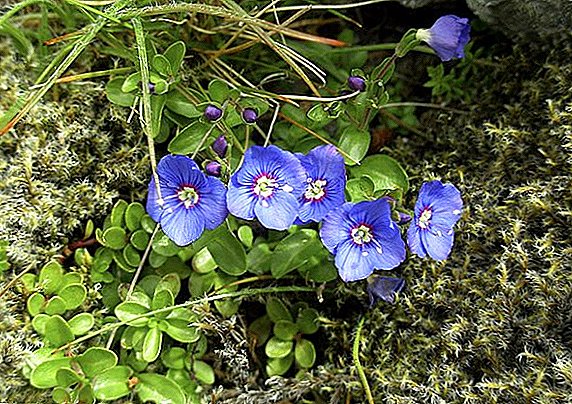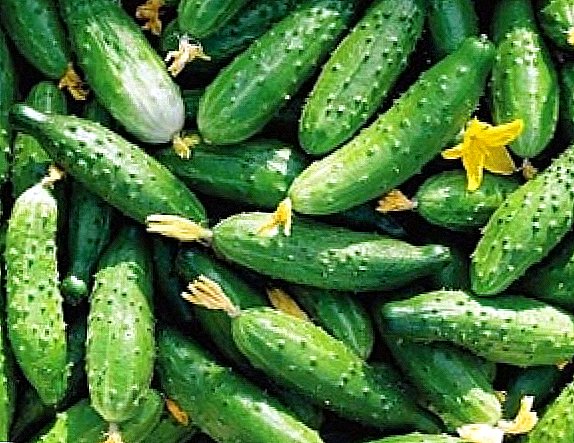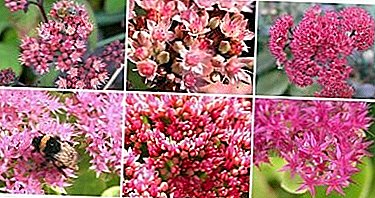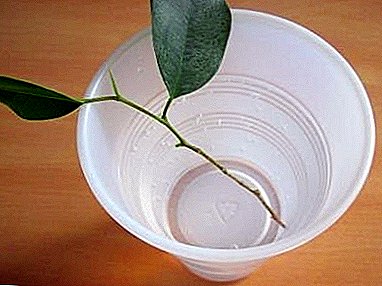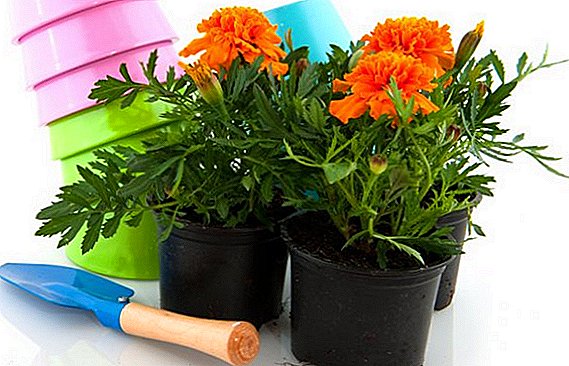 Agrotechnology marigolds is so simple that even a novice gardener can handle it. Flowers are unpretentious, so you almost always get the expected result. You can plant flowers by sowing seeds directly into the ground, and you can pre-grow seedlings. What is the difference between these two ways and what are the advantages of each, we will tell further.
Agrotechnology marigolds is so simple that even a novice gardener can handle it. Flowers are unpretentious, so you almost always get the expected result. You can plant flowers by sowing seeds directly into the ground, and you can pre-grow seedlings. What is the difference between these two ways and what are the advantages of each, we will tell further.
Growing marigolds through seedlings
One of the most reliable ways to decorate your garden with lush bushes of marigolds is growing seedlings. Then you can land them on the site in the planned amount.
The best time for sowing seeds for seedlings
Marigolds are not particularly demanding to environmental conditions, so the time for planting is chosen mainly for the time when you need to get flowering bushes. They can be sown on seedlings even in early spring. 
Important! There are many varieties of marigolds, and many of them have different preparation times for flowering. Thus, upright marigolds require more time for growing season, and small-leaf and short-growing ones - less. Accordingly, there are different dates for planting marigolds. If the first to land in mid-March, and the rest in early April, then by June they will give a friendly flowering.
Seedling method helps to get earlier flowering. Having planted the seeds in the seedling boxes or individual pots, in a month and a half you will receive planting material, and a month after planting in open ground - flowering plants.
With the help of seedlings you can grow other flowers for the garden: petunia, Levkoy, Lisianthus, Turkish carnation, zinnia, platicodon.
Composition of soil mixture
The plant is not very demanding on the soil, but it is still worthwhile for the seedlings to provide suitable soil so that it grows strong and viable. To do this, prepare a mixture of equal parts of turf, peat and humus, additionally it is mixed with half of the sand.  It must necessarily be disinfected with a solution of potassium permanganate or a fungicide. After that, you can make any organic fertilizer with the exception of fresh manure. Then, about three centimeters of drainage are poured into the seedling box: expanded clay, sand, crushed stone.
It must necessarily be disinfected with a solution of potassium permanganate or a fungicide. After that, you can make any organic fertilizer with the exception of fresh manure. Then, about three centimeters of drainage are poured into the seedling box: expanded clay, sand, crushed stone.
How to prepare and properly plant the seeds
Seeds can be planted unprepared, but some gardeners still prefer to germinate them in advance. To do this, they are soaked in water at room temperature for 10 minutes, and then spread in a flat saucer, cover with a damp cloth, wrap with plastic wrap. Saucer clean in a warm place.
Often, experienced growers practice planting marigolds with germinated seeds. To do this, they need to lay out on a plate and cover with a damp cloth, then wrap a plastic bag and put in a warm place. As a rule, they have three days to germinate.
Did you know? Today science has confirmed the healing properties of marigolds, which were known to our ancestors. For example, they contain a lot of lutein, which is an excellent prophylactic against cataracts. Folk healers treated with marigolds inflammation of the pancreas, diabetes mellitus. Tincture treat colds, bronchitis, asthma, stomatitis, purify the blood.
 Seed can be planted in two ways. The most common - sowing in pre-harvested grooves. Make them at a distance of 1.5 - 2 cm from each other and pour out the seeds. If they have not been previously germinated, it is convenient to take a folded sheet of paper in half, place the seeds on it and pour it through the fold.
Seed can be planted in two ways. The most common - sowing in pre-harvested grooves. Make them at a distance of 1.5 - 2 cm from each other and pour out the seeds. If they have not been previously germinated, it is convenient to take a folded sheet of paper in half, place the seeds on it and pour it through the fold.  If planting is done with germinated seeds, it is better to use pots with a diameter of not more than 4 cm. They are placed one by one - two grains. It can be planted in boxes, keeping the distance between the seed 2 x 2 cm. Seeds are sprinkled with soil and sprayed the landing site from a spray bottle.
If planting is done with germinated seeds, it is better to use pots with a diameter of not more than 4 cm. They are placed one by one - two grains. It can be planted in boxes, keeping the distance between the seed 2 x 2 cm. Seeds are sprinkled with soil and sprayed the landing site from a spray bottle. 
Conditions for germinating seeds
In order for the seeds to germinate, a box with planting material planted in it must be placed in a lit place. The ambient temperature should be 22 - 25 ° C. Then the first shoots will appear in five days. When they appear, the air temperature can be reduced to 18 - 20 ° C. 
Caring for marigold seedlings
So, after the appearance of the first shoots, the boxes with the seedlings are removed to a cooler, but no less lit place. Further, the question arises: is it necessary to dive marigolds? Many growers recommend to carry out this procedure after a couple of true leaves appear on the sprouts. Then it should be seated at a distance of 7x7 cm. This will provide better lighting, and therefore the sprouts will not stretch too much. 
Important! Marigolds without consequences suffer not only a dive, but also a transplant. And you can replant them even during flowering.
Care for seedlings does not present any difficulties. It should be regularly watered with separated water, maintained at about 20 ° C and periodically ventilated.  While the shoots are small and fragile, it is advisable to water from a spray bottle so that the water does not erode the soil near the roots.
While the shoots are small and fragile, it is advisable to water from a spray bottle so that the water does not erode the soil near the roots.  Two weeks after a dive, you can plant marigolds in a country house in open ground.
Two weeks after a dive, you can plant marigolds in a country house in open ground. 
Planting marigold seedlings in open ground
Marigolds easily tolerate transplants, but this process still requires adherence to certain rules.
When seedlings are planted
It is desirable to plant flowers on a permanent place at the end of May, when the threat of frost on the ground passes. Still, this plant, which came from the warm edges, therefore, is experiencing frosts badly. Ensure that each seedling planted has at least three leaves and a strong root system. 
Important! Most of the varieties of marigolds that are used today in gardens are hybrids. This means that if such marigolds multiply by seed, they can be very different from the mother plant. But not for the worse. Sometimes you can get amazingly beautiful specimens.
Choosing a landing site
Choosing where to plant marigold seedlings, stop in a well-lit place. They will be able to grow in partial shade and in the shade, but there marigolds will not be so lush and bright.
Similarly with the soil. It can be any, but on neutral loams with a good level of fertility, they will be thick and will give abundant flowering. In the first half of summer, the soil should be watered well, and if it is infertile, then in the summer it should be fertilized two or three times.
How to plant marigold seedlings on the plot
 Taking up the cultivation of marigolds, it is important to know not only how to grow seedlings, but also how to properly plant them in open ground. Planting scheme marigold depends on what varieties are planted in the garden. So, undersized varieties are planted at a distance of 20 cm from each other, sredneroslye - 30 cm, and high under the scheme 40 x 40 cm.
Taking up the cultivation of marigolds, it is important to know not only how to grow seedlings, but also how to properly plant them in open ground. Planting scheme marigold depends on what varieties are planted in the garden. So, undersized varieties are planted at a distance of 20 cm from each other, sredneroslye - 30 cm, and high under the scheme 40 x 40 cm.
Planted in the hole for one plant. As a rule, after a dive, seedlings quickly grow stronger and form a powerful root system. Therefore, when planting in open ground, the plant takes root quickly. It is only important to water the seedlings well and continue to water it abundantly until it is strong. In general, marigolds survive and drought, but the bushes grow low, sparse, puny, releasing small inflorescences. 
Growing marigolds from seeds in open ground
Sowing marigolds in open ground should be carried out only with fresh seeds. Germination they retain up to two years, but fresh germination is great. Good seed thickness is given by pre-germinated seeds. To do this, they are soaked in water at room temperature for a couple of days. But sowing is allowed and dry.
Did you know? In South America, the local population since ancient times used marigolds as a seasoning. In the Caucasus, they are added to pastries, pickles, used to make sauces, soups, and main courses. They even received the second name "Imeretinsky saffron". In France, they are grown on an industrial scale for the purpose of use in cooking.
When to sow seeds in the ground
When grown from seeds in open ground, marigolds are sown in May, when there is confidence that there will be no more frost on the ground. In the northern regions, after sowing, it is recommended to cover the place for two weeks with non-woven material to protect the crops from frost. The first shoots should appear in a couple of weeks. 
Preparation and planting marigold seeds in the ground
Flower growers who know everything about marigolds recommend sowing germinated seeds. How to do this, we spoke above when we talked about the preparation of seeds for sowing for seedlings. If it is decided to sow them dry in the open ground, grooves are made about 5 cm deep in the selected area. The trench is moistened with water and seeds are poured into it at a distance of 5 cm from each other. Then the furrow is sprinkled with soil or peat and watered again.
Seedling care
Growth rate depends on environmental conditions. In warm regions, flowers will sprout faster than in cold ones. But in any case, when 2-3 true leaves are formed on the sprouts, the sprouts must be thinned or there is an opportunity to swoop out the sprouts. Between plants should be a distance of about 20 cm, and if we are talking about tall plants, then all 40 cm.  Shoots need to be watered regularly, not allowing the soil to dry out. While the sprouts are weak, they require regular weeding.
Shoots need to be watered regularly, not allowing the soil to dry out. While the sprouts are weak, they require regular weeding.
How to care for marigolds in the process of growing
Now it is necessary to dwell on how to care for marigolds growing in a flowerbed in the garden.
How to conduct watering
Caring for marigolds involves regular watering. However, it is important that the moisture in the soil does not stagnate, otherwise the plants begin to rot due to the lack of air access to the roots. Before flowering, watering is recommended to reduce a little - excess moisture leads to rotting of the inflorescences. If this happens, damaged baskets should be immediately cut off and destroyed outside the site. 
Weeding and loosening between the rows
Flowerbed with marigolds should be regularly loosened, because the roots of these flowers love the air. During loosening, be sure to perform weeding, especially when the sprouts are young and not strong. Over time, they themselves will drown out some weeds, but loosening the soil should be carried out constantly.
How to conduct dressing
As already mentioned, marigolds are not demanding to the soil and do not require special dressings. However, additional nutrients have a positive effect on their growth and appearance. If the flowers are planted on sandy or scanty soil, the application of top dressings is more relevant.  The first dressing can be done when the flowers reach 10 cm in height, the second - when forming buds, and the third right before flowering. To do this, use complex fertilizers. You can add dried or oblique siderata, rotted weed compost and other organic matter except fresh manure.
The first dressing can be done when the flowers reach 10 cm in height, the second - when forming buds, and the third right before flowering. To do this, use complex fertilizers. You can add dried or oblique siderata, rotted weed compost and other organic matter except fresh manure.
Pruning inflorescences
Few people know, but in order for marigolds to bloom better and thicker, they should remove faded blossoms. It is also possible to periodically trim bushes, especially tall varieties. This will help form lush bushes.
Combination of marigolds with other plants
 Marigolds are actively used when planting carpet flower beds. In this case, they look great in company with ageratum, coleus, cineraria, begonia and similar plants. Chernobrivtsy rescue a young garden, on which there are still many plots not planted with plants. They are planted in the place of faded bulbous or places where other plants have wintered.
Marigolds are actively used when planting carpet flower beds. In this case, they look great in company with ageratum, coleus, cineraria, begonia and similar plants. Chernobrivtsy rescue a young garden, on which there are still many plots not planted with plants. They are planted in the place of faded bulbous or places where other plants have wintered.
Excellent these flowers look in flower beds and flower beds, where there are not enough bright and catchy flowers. It may be planting sites for conifers with a gray or blue color, purple or bright blue asters.  Been in flowerbeds and various varieties of marigolds. So, for example, in the middle of a flower bed with a venide, mallow, amaranth, castor oil, cannes, large-flowered Chernobrivtsi are planted. If the flower bed is formed from medium-sized plants (cineraria, fragrant tobacco, salvia), varieties of medium height are used, respectively. Low-growing marigolds are planted along the edge of the flower beds along with a gatzania, begonia, balsamine for framing a flower garden.
Been in flowerbeds and various varieties of marigolds. So, for example, in the middle of a flower bed with a venide, mallow, amaranth, castor oil, cannes, large-flowered Chernobrivtsi are planted. If the flower bed is formed from medium-sized plants (cineraria, fragrant tobacco, salvia), varieties of medium height are used, respectively. Low-growing marigolds are planted along the edge of the flower beds along with a gatzania, begonia, balsamine for framing a flower garden.
Collection and storage of marigold seeds
Ordinary varieties of marigolds are usually annual plants, respectively, in the fall the bushes are removed from the beds. But if you want to get the same flowers for the next year, you need to collect seeds from them.
Did you know? Do not rush to throw marigold bushes after uprooting. If you add them to the compost pit, you will repel the midges from it. One bucket of wilted Chernobrivtsi is enough to get rid of annoying insects.
 Marigolds have inflorescences of two types: female and bisexual. The first petals are located on the periphery, the so-called velvet flowers. In the second they are located around the center of the flower. It is bisexual that produce more seeds because they are self-pollinated. But the terry and velvet is transmitted only through the female inflorescences. Therefore, for decorative flowers, it is desirable to collect seeds from female flowers.
Marigolds have inflorescences of two types: female and bisexual. The first petals are located on the periphery, the so-called velvet flowers. In the second they are located around the center of the flower. It is bisexual that produce more seeds because they are self-pollinated. But the terry and velvet is transmitted only through the female inflorescences. Therefore, for decorative flowers, it is desirable to collect seeds from female flowers.From the moment of flower blooming and until the formation of full seeds, it takes at least 40 days. You can remove them when the inflorescences turn yellow and dry completely, and the stems turn brown. Carefully cut the inflorescence, pour the seeds into a cardboard box or paper bag so that they do not deteriorate during storage.
Important! Fully ripen seeds can only in sunny weather. It is recommended to collect them too only in dry and warm time.
If summer is wet or wet days are delayed, leaving the seeds for ripening in such conditions is not recommended, otherwise they will dampen and rot. To avoid this, in the coming sundial, the inflorescences are cut together with the stems, tied up in bunches and hung to dry in a dry and ventilated place.  Bundles are placed heads down, and spread out paper under them. As the seeds dry, they will crumble onto a paper sheet, from which they are then easy to collect. They will be no different from those that were collected in the usual way.
Bundles are placed heads down, and spread out paper under them. As the seeds dry, they will crumble onto a paper sheet, from which they are then easy to collect. They will be no different from those that were collected in the usual way.
How to store marigold seeds? They are put in a paper bag and kept in a dry dark place. On average, seeds remain viable for up to two years, but can sometimes germinate even after four years.
Resistance of marigolds to diseases and pests
Marigolds are known for their resistance to fungal diseases. Specific substances volatile, which give them a special aroma, protect the flower from harmful fungi. Moreover, the plant is able to protect other plants from them, so marigolds are often planted for prophylaxis near crops that are susceptible to similar diseases,  Sometimes in a damp summer gray rot can appear on the leaves and stems of the plant. Then the injured bushes must be removed and destroyed outside the site. In conditions of high humidity marigold bushes can attack slugs and snails. You can fight them with bleach. Small containers filled with the medium are placed between the beds. A pungent smell repels pests.
Sometimes in a damp summer gray rot can appear on the leaves and stems of the plant. Then the injured bushes must be removed and destroyed outside the site. In conditions of high humidity marigold bushes can attack slugs and snails. You can fight them with bleach. Small containers filled with the medium are placed between the beds. A pungent smell repels pests.
Arid weather is favorable for spider mites. Therefore, make sure that the soil is always wet. If the insect still attacked your marigolds, spray them with an infusion of hot red pepper, yarrow or onion once a day, in the morning or evening. The rest of the flowers are resistant to disease and pests.  Growing marigolds in your garden is simple and always beneficial. In 99% of cases, your efforts and costs will be fully justified, as these are unpretentious and very spectacular flowers. Bright blooms and an unusual form of flowers, they will enliven every corner of the garden. Depending on the variety, you can choose tall, medium-growth or low-growing plants. They are a little susceptible to diseases, and in addition serve as an excellent prevention from diseases for other plants.
Growing marigolds in your garden is simple and always beneficial. In 99% of cases, your efforts and costs will be fully justified, as these are unpretentious and very spectacular flowers. Bright blooms and an unusual form of flowers, they will enliven every corner of the garden. Depending on the variety, you can choose tall, medium-growth or low-growing plants. They are a little susceptible to diseases, and in addition serve as an excellent prevention from diseases for other plants.






